International Women’s Day 2020: History, theme and importance
The day isn’t simply a celebration — it’s a call to action for everyone to continue to push for complete gender equality.
International Women’s Day has celebrated the economic, cultural, political and social achievements of women for more than 100 years. From Greta Thunberg becoming an international sensation with her campaign for climate change last year to Chloe Kim snowboarding loops around Olympic records at the PyeongChang Games in 2018, women across the globe have been challenging stereotypes and the status quo.
The day isn’t simply a celebration — it’s a call to action for everyone to continue to push for complete gender equality.
International Women’s Day 2020 campaign theme is #EachforEqual
An equal world is an enabled world.
Individually, we’re all responsible for our own thoughts and actions – all day, every day.
We can actively choose to challenge stereotypes, fight bias, broaden perceptions, improve situations and celebrate women’s achievements.
Collectively, each one of us can help create a gender equal world.
Let’s all be #EachforEqual.
1. What is its history?
The early 20th century was a time when women were becoming more active in their protests against oppression and gender inequality, leading marches and campaigns to demand equal rights. According to the official International Women’s Day website, during the International Conference of Working Women in 1910, Clara Zetkin of Germany’s Social Democratic Party proposed that a day be set aside every year across the world to celebrate women and reinforce their demands. The proposal was ultimately accepted and put into practice, starting in Germany and Europe and spreading across the globe over the years.
About International Women’s Day
International Women’s Day (IWD) is celebrated annually on March 8.
The day has occurred for well over a century, with the first IWD gathering in 1911.
The day is not country, group or organization specific – and belongs to all groups collectively everywhere.
Gloria Steinem, world-renowned feminist, journalist and activist once explained “The story of women’s struggle for equality belongs to no single feminist nor to any one organization but to the collective efforts of all who care about human rights.”
So make International Women’s Day your day and do what you can to truly make a positive difference for women.
What is International Women’s Day?
International Women’s Day (March 8) is a global day celebrating the social, economic, cultural and political achievements of women. The day also marks a call to action for accelerating gender parity.
No one government, NGO, charity, corporation, academic institution, women’s network or media hub is solely responsible for International Women’s Day. Many organizations declare an annual IWD theme that supports their specific agenda or cause, and some of these are adopted more widely with relevance than others. International Women’s Day is a collective day of global celebration and a call for gender parity.
International Women’s Day is all about unity, celebration, reflection, advocacy and action – whatever that looks like globally at a local level. But one thing is for sure, International Women’s Day has been occurring for well over a century – and continue’s to grow from strength to strength. Learn about the values that guide IWD’s ethos.
What colours signify International Women’s Day?
Internationally, purple is a colour for symbolising women. Historically the combination of purple, green and white to symbolise women’s equality originated from the Women’s Social and Political Union in the UK in 1908. Purple signifies justice and dignity. Green symbolises hope. White represents purity, but is no longer used due to ‘purity’ being a controversial concept.
What’s the history of IWD?
International Women’s Day (IWD) has been observed since the early 1900’s – a time of great expansion and turbulence in the industrialized world that saw booming population growth and the rise of radical ideologies.
1908
Great unrest and critical debate was occurring amongst women. Women’s oppression and inequality was spurring women to become more vocal and active in campaigning for change. Then in 1908, 15,000 women marched through New York City demanding shorter hours, better pay and voting rights.
1909
In accordance with a declaration by the Socialist Party of America, the first National Woman’s Day (NWD) was observed across the United States on 28 February. Women continued to celebrate NWD on the last Sunday of February until 1913.
1910
In 1910 a second International Conference of Working Women was held in Copenhagen. A woman named Clara Zetkin (Leader of the ‘Women’s Office’ for the Social Democratic Party in Germany) tabled the idea of an International Women’s Day. She proposed that every year in every country there should be a celebration on the same day – a Women’s Day – to press for their demands. The conference of over 100 women from 17 countries, representing unions, socialist parties, working women’s clubs – and including the first three women elected to the Finnish parliament – greeted Zetkin’s suggestion with unanimous approval and thus International Women’s Day was the result.
1911
Following the decision agreed at Copenhagen in 1911, International Women’s Day was honoured the first time in Austria, Denmark, Germany and Switzerland on 19 March. More than one million women and men attended IWD rallies campaigning for women’s rights to work, vote, be trained, to hold public office and end discrimination. However less than a week later on 25 March, the tragic ‘Triangle Fire’ in New York City took the lives of more than 140 working women, most of them Italian and Jewish immigrants. This disastrous event drew significant attention to working conditions and labour legislation in the United States that became a focus of subsequent International Women’s Day events. 1911 also saw women’s Bread and Roses’ campaign.
1913-1914
On the eve of World War I campaigning for peace, Russian women observed their first International Women’s Day on the last Sunday in February 1913. In 1913 following discussions, International Women’s Day was transferred to 8 March and this day has remained the global date for International Women’s Day ever since. In 1914 further women across Europe held rallies to campaign against the war and to express women’s solidarity. For example, in London in the United Kingdom there was a march from Bow to Trafalgar Square in support of women’s suffrage on 8 March 1914. Sylvia Pankhurst was arrested in front of Charing Cross station on her way to speak in Trafalgar Square.
1917
On the last Sunday of February, Russian women began a strike for “bread and peace” in response to the death of over 2 million Russian soldiers in World War 1. Opposed by political leaders, the women continued to strike until four days later the Czar was forced to abdicate and the provisional Government granted women the right to vote. The date the women’s strike commenced was Sunday 23 February on the Julian calendar then in use in Russia. This day on the Gregorian calendar in use elsewhere was 8 March.
1975
International Women’s Day was celebrated for the first time by the United Nations in 1975. Then in December 1977, the General Assembly adopted a resolution proclaiming a United Nations Day for Women’s Rights and International Peace to be observed on any day of the year by Member States, in accordance with their historical and national traditions.
1996
The UN commenced the adoption of an annual theme in 1996 – which was “Celebrating the past, Planning for the Future”. This theme was followed in 1997 with “Women at the Peace table”, and in 1998 with “Women and Human Rights”, and in 1999 with “World Free of Violence Against Women”, and so on each year until the current. More recent themes have included, for example, “Empower Rural Women, End Poverty & Hunger” and “A Promise is a Promise – Time for Action to End Violence Against Women”.
2000
By the new millennium, International Women’s Day activity around the world had stalled in many countries. The world had moved on and feminism wasn’t a popular topic. International Women’s Day needed re-ignition. There was urgent work to do – battles had not been won and gender parity had still not been achieved.
2001
The global internationalwomensday.com digital hub for everything IWD was launched to re-energize the day as an important platform to celebrate the successful achievements of women and to continue calls for accelerating gender parity. Each year the IWD website sees vast traffic and is used by millions of people and organizations all over the world to learn about and share IWD activity. The IWD website is made possible each year through support from corporations committed to driving gender parity. The website’s charity of choice for many years has been the World Association of Girl Guides and Girl Scouts (WAGGGS) whereby IWD fundraising is channelled. A more recent additional charity partnership is with global working women’s organization Catalyst Inc. The IWD website adopts an annual campaign theme that is globally relevant for groups and organizations. This campaign theme, one of many around the world, provides a framework and direction for annual IWD activity and takes into account the wider agenda of both celebration as well as a broad call to action for gender parity. Recent campaign themes have included: #BalanceforBetter, #PressforProgress, #BeBoldforChange, #PledgeforParity, #MakeItHappen, #TheGenderAgenda and more. Campaign themes for the global IWD website are collaboratively developed each year with stakeholders and widely adopted worldwide.
2011
2011 saw the 100 year centenary of International Women’s Day – with the first IWD event held exactly 100 years ago in 1911 in Austria, Denmark, Germany and Switzerland. In the United States, President Barack Obama proclaimed March 2011 to be “Women’s History Month”, calling Americans to mark IWD by reflecting on “the extraordinary accomplishments of women” in shaping the country’s history. The then Secretary of State Hillary Clinton launched the “100 Women Initiative: Empowering Women and Girls through International Exchanges”. In the United Kingdom, celebrity activist Annie Lennox lead a superb march across one of London’s iconic bridges raising awareness in support for global charity Women for Women International. Further charities such as Oxfam have run extensive activity supporting IWD and many celebrities and business leaders also actively support the day
2020 and beyond
The world has witnessed a significant change and attitudinal shift in both women’s and society’s thoughts about women’s equality and emancipation. Many from a younger generation may feel that ‘all the battles have been won for women’ while many feminists from the 1970’s know only too well the longevity and ingrained complexity of patriarchy. With more women in the boardroom, greater equality in legislative rights, and an increased critical mass of women’s visibility as impressive role models in every aspect of life, one could think that women have gained true equality. The unfortunate fact is that women are still not paid equally to that of their male counterparts, women still are not present in equal numbers in business or politics, and globally women’s education, health and the violence against them is worse than that of men. However, great improvements have been made. We do have female astronauts and prime ministers, school girls are welcomed into university, women can work and have a family, women have real choices. And so each year the world inspires women and celebrates their achievements. IWD is an official holiday in many countries including Afghanistan, Armenia, Azerbaijan, Belarus, Burkina Faso, Cambodia, China (for women only), Cuba, Georgia, Guinea-Bissau, Eritrea, Kazakhstan, Kyrgyzstan, Laos, Madagascar (for women only), Moldova, Mongolia, Montenegro, Nepal (for women only), Russia, Tajikistan, Turkmenistan, Uganda, Ukraine, Uzbekistan, Vietnam and Zambia. The tradition sees men honouring their mothers, wives, girlfriends, colleagues, etc with flowers and small gifts. In some countries IWD has the equivalent status of Mother’s Day where children give small presents to their mothers and grandmothers.
A global web of rich and diverse local activity connects women from all around the world ranging from political rallies, business conferences, government activities and networking events through to local women’s craft markets, theatric performances, fashion parades and more. Many global corporations actively support IWD by running their own events and campaigns. For example, on 8 March search engine and media giant Google often changes its Google Doodle on its global search pages to honor IWD. Year on year IWD is certainly increasing in status.
So make a difference, think globally and act locally!
Make everyday International Women’s Day.
Do your bit to ensure that the future for girls is bright, equal, safe and rewarding.
42 years, 7 months and 16 days
… the length of time between when a constitutional amendment granting a woman’s right to vote was introduced in the U.S. Congress (Jan. 10, 1878) and when it was finally ratified (Aug. 26, 1920).

2. When is it observed?
The first International Women’s Day was observed March 8, 1914. Even though International Women’s Day was decided upon in 1910, the tradition of celebrating it on March 8 took a few more years to decide upon.
In 1975, the United Nations announced that International Women’s Day would be an official day of observance for all of its member countries. Years later, the world body also instituted annual themes to promote the celebration of the day, such as “Celebrating the Past, Planning for the Future” and “World Free of Violence Against Women.”
47%
… of the U.S. workforce is made up of women.
what is the color
Purple is the internationally recognized color to symbolize women while the combination of the colors green, purple and white is meant to represent women’s equality, according to the IWD website. Purple, or the combination of those colors, may be displayed to celebrate International Women’s Day.
9.7%
… of U.S. couples in which the wife earned at least $30,000 more than her husband.

5. How is it celebrated?
Every country has its own special tradition for celebrating International Women’s Day. In Italy, for example, the day is celebrated by giving women a mimosa blossom. You can celebrate the day on social media by posting pictures of yourself with your hand out like a set of scales and using the hashtags #BalanceforBetter and #IWD2019. People also share posts of themselves celebrating the women in their lives and showing how they are actively working to support women.
70%
… women with children younger than 18 who participate in the U.S. labor force6. Why is it still observed?
Women have come a long way since that conference in 1910, and many people believe that most of the battles have already been won for women. But according to the IWD website, women are still not getting equal pay, there are lower proportions of women to men in government positions, and women’s education is still being withheld across the world. Battles have been won, but the battles aren’t over yet.




